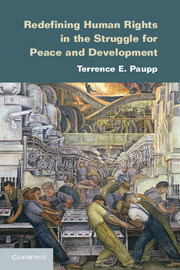Book contents
- Frontmatter
- Dedication
- Contents
- List of Tables
- Foreword
- Acknowledgments
- Introduction
- 1 The greatest undiagnosed problem in international law
- 2 From disparity to centrality: How the human rights to peace and development can be secured
- 3 Confronting structural injustice: Strategies of localization, regionalism, and an emerging global constitutional order
- 4 The power of law versus the law of power: How human rights can overcome inequality, poverty, and vested interests
- 5 A world community that includes all human communities: Indigenous communities and the global environment as sources for human rights claims
- 6 Actualizing the human right to peace: Paths for developing processes and creating conditions for peace
- Conclusion Transformation through cooperation: Implementing a human rights–based approach to human security
- Biography of Terrence E. Paupp
- Appendix 1 Principles Relating to the Status of National Institutions (The Paris Principles)
- Appendix 2 Tilburg Guiding Principles on World Bank, IMF, and Human Rights
- Appendix 3 Universal Declaration of the Rights of Peoples (Algiers, 4 July 1976)
- Appendix 4 The Freedom Charter (Africa, 1955)
- Index
- References
2 - From disparity to centrality: How the human rights to peace and development can be secured
Published online by Cambridge University Press: 05 June 2014
- Frontmatter
- Dedication
- Contents
- List of Tables
- Foreword
- Acknowledgments
- Introduction
- 1 The greatest undiagnosed problem in international law
- 2 From disparity to centrality: How the human rights to peace and development can be secured
- 3 Confronting structural injustice: Strategies of localization, regionalism, and an emerging global constitutional order
- 4 The power of law versus the law of power: How human rights can overcome inequality, poverty, and vested interests
- 5 A world community that includes all human communities: Indigenous communities and the global environment as sources for human rights claims
- 6 Actualizing the human right to peace: Paths for developing processes and creating conditions for peace
- Conclusion Transformation through cooperation: Implementing a human rights–based approach to human security
- Biography of Terrence E. Paupp
- Appendix 1 Principles Relating to the Status of National Institutions (The Paris Principles)
- Appendix 2 Tilburg Guiding Principles on World Bank, IMF, and Human Rights
- Appendix 3 Universal Declaration of the Rights of Peoples (Algiers, 4 July 1976)
- Appendix 4 The Freedom Charter (Africa, 1955)
- Index
- References
Summary
Globalization . . . has implications for normative jurisprudence. It has stimulated a revival of concern about universalism and relativism in ethics, it has provoked the ‘Asian values’ debates, and it has contributed to a new wave of rethinkings of the scope and justifications of human rights as moral, political, and legal rights
(Twining 2009, 445).Human rights are more than freedom from State interference, although this is a key tenet. They are also about freedom to be and do what one values; the right to the resources and powers necessary to facilitate equal participation in civil, economic, and political society. Nor is it correct to view human rights as simply protecting the individual, separate from society. Basic human rights values are essentially communal . . . Transforming human rights therefore entails the recognition that the power of the State needs to be harnessed to securing the genuine exercise of human rights. This in turn means that human rights of all kinds, whether civil and political or socioeconomic, can only be fully enjoyed if they give rise to a range of duties on the State. These extend beyond the well-established duty of restraint from interference. Critically, they also include positive duties
(Fredman 2008, viii).[W]e live in a normative world where international law and concepts of right, and rule of law have legal, political, and moral power. Not everything is freely negotiable, as agreements that do not address injustice and exclusion will not sustain peace in any meaningful sense of the word. Justice and inclusion are both normative, but also intensely practical requirements of lasting peace. International law is one of the few instruments capable of being appealed to as providing a lodestar of fairness, which has some claim to objectivity as between the parties to the conflict. This gives it political power
(Bell 2008, 300).- Type
- Chapter
- Information
- Publisher: Cambridge University PressPrint publication year: 2014

